Wearable apps have become an integral part of our daily lives.
Offering convenience, health tracking, and real-time connectivity. The best part is all of this is packed right on our wrists.
If you’re considering entering this rapidly growing market, understanding the cost to build a wearable app is crucial.
On average wearable app development cost can range from $30,000 to $150,000, depending on factors like app complexity, platform compatibility, and design requirements.
This blog explores the various aspects of app development, including the factors affecting costs, popular apps, and strategies to optimize your budget.
What Are Wearable Apps Exactly?
Wearable apps are software applications specifically designed to operate on wearable devices.
This includes smartwatches, fitness trackers, and augmented reality (AR) glasses.
These apps integrate seamlessly with the wearable device’s hardware to deliver personalized and real-time data to the user.
Whether it’s tracking physical activity, monitoring health metrics, or providing notifications, wearable apps are tailored to enhance the functionality of these compact devices.
The growing adoption of wearable technology has led to an increase in demand.
As wearable technology continues to evolve, the scope and impact of wearable apps are expected to expand significantly.
Should You Develop a Wearable App in 2024?
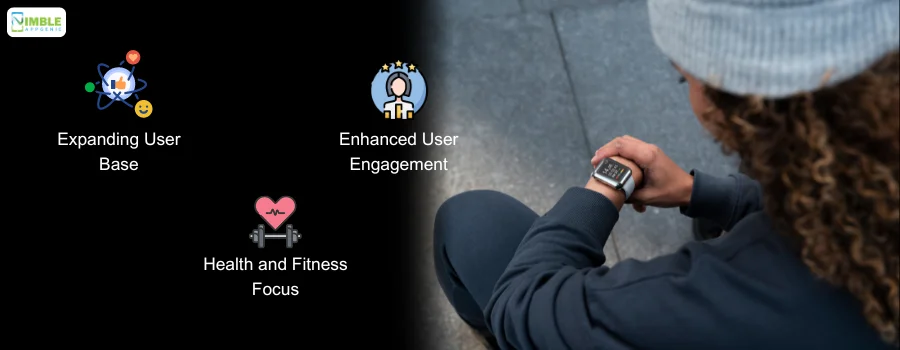
Mobile app development projects can be a big task to go for.
So, this naturally brings up the question, “Should I Develop a Wearable App?”
As we enter 2024, the wearable technology market is experiencing exponential growth.
According to recent statistics, the global wearable technology market is expected to reach $118.16 billion by 2028, with a compound annual growth rate (CAGR) of 15.3% from 2023.
This growth underscores the increasing consumer demand for wearable devices, which in turn drives the need for wearable apps.
1. Expanding User Base
Mobile app statistics show amazing growth in the market.
With over 1.1 billion connected wearable devices globally as of 2023, the user base for wearable technology is rapidly expanding.
This growing market presents a lucrative opportunity for businesses and developers to create wearable apps that cater to a wide audience.
2. Enhanced User Engagement
Want your platform to be successful among people?
Wearable apps offer a more intimate and personalized user experience, leading to higher engagement levels.
Whether it’s for health tracking, real-time notifications, or seamless connectivity, wearable apps keep users connected and engaged like never before.
3. Health and Fitness Focus
The demand for health and fitness apps is on the rise, with wearable devices playing a crucial role in monitoring and improving users’ well-being.
Developing a wearable app focused on fitness tracking, health monitoring, or wellness can tap into this growing trend.
Going for wearable app in 2024 can position your brand at the forefront of technological innovation. The cost to make a wearable app is a strategic investment that can lead to increased user engagement, brand loyalty, and overall business growth.
Average Cost to Develop a Wearable App
So, how much does it cost to develop a wearable app?
The cost to develop a wearable app typically ranges between $30,000 and $150,000, depending on various factors that influence the overall budget.
Below, we provide a more detailed overview of how these factors impact the total app development cost.
| Factor | Cost Impact |
| 1. App Complexity | $30,000 – $60,000 for basic features, up to $150,000 for complex apps |
| 2. Platform and Device Compatibility | +$10,000 – $30,000 depending on the number of platforms and devices |
| 3. Design and UI/UX | $5,000 – $20,000 depending on design complexity |
| 4. Development Team Location | +$50 – $150/hour for North America/Western Europe, $20 – $50/hour for Eastern Europe/Asia |
| 5. Integration and Testing | $5,000 – $15,000 depending on integration and testing needs |
The overall cost of developing a wearable app depends on the specific requirements of your project.
By understanding how these factors impact the budget, you can better estimate the cost to create a wearable app that meets your needs.
Popular Wearable Apps and the Cost to Clone Them
Wearable apps have become essential for various functions, from fitness tracking to health monitoring.
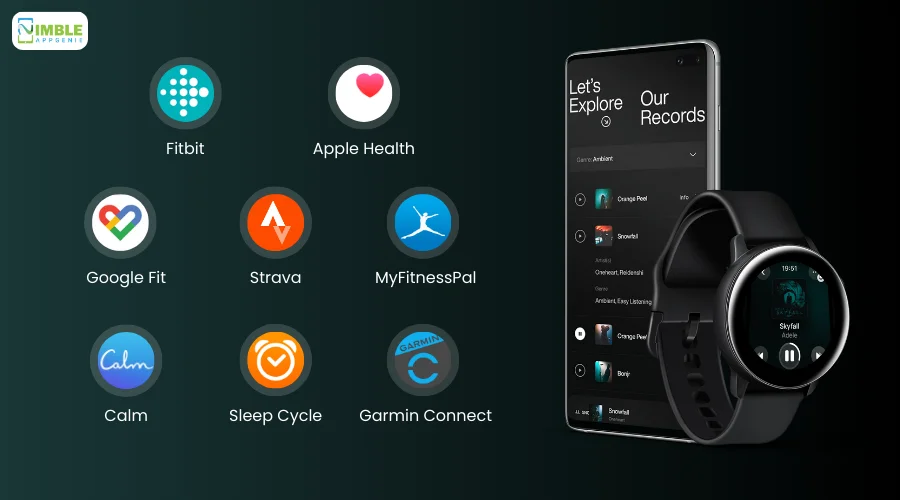
Below are some of the most popular wearable apps, along with an estimated cost to develop a similar app.
► Fitbit
Fitbit is one of the most recognized names in the wearable industry, primarily known for its fitness-tracking capabilities.
The app allows users to monitor their daily activity, sleep patterns, heart rate, and more. It also offers features like social integration and personalized health insights.
Cost To Develop An App Like FitBit : $70,000 – $150,000
► Apple Health
Apple Health is a comprehensive health and fitness tracking app that integrates seamlessly with iOS and watchOS devices.
It aggregates data from various health apps and devices, providing users with a complete picture of their health metrics.
The app includes advanced features such as heart rate monitoring, sleep analysis, and workout tracking.
Cost To Develop An App Like Apple : $100,000 – $200,000
► Google Fit
Google Fit is Google’s answer to health and fitness tracking.
The app works across Android devices and integrates with various wearables to track physical activity, heart rate, and more.
Google Fit also connects with third-party apps, offering a centralized hub for all health-related data.
Cost To Develop An App Like Google Fit: $60,000 – $120,000
► Strava
Strava is a popular app among runners and cyclists, offering detailed tracking of workouts, GPS routes, and performance analytics.
It also includes social features, allowing users to share their activities, compete with others, and participate in challenges.
Cost To Develop An App Like Strava: $80,000 – $160,000
► MyFitnessPal
MyFitnessPal is a leading app for tracking diet and exercise.
It provides a comprehensive database of food items, enabling users to monitor their calorie intake, track their exercise routines, and set fitness goals.
The app’s extensive features and user-friendly interface make it a go-to for many health-conscious individuals.
Cost To Develop An App Like MyFitnessPal: $90,000 – $180,000
► Calm
Calm is a wellness app focused on meditation, sleep, and relaxation.
It offers guided meditation, sleep stories, breathing exercises, and soothing music to help users reduce stress and improve their mental health.
Cost To Develop An App Like Calm: $70,000 – $150,000
► Sleep Cycle
Sleep Cycle is an intelligent alarm clock app that analyzes your sleep patterns and wakes you up during the lightest sleep phase, ensuring you feel refreshed.
It also tracks sleep quality, snoring, and other metrics to provide insights into your sleep health.
Cost To Develop An App Like Sleep Cycle: $60,000 – $120,000
► Garmin Connect
Garmin Connect is a robust fitness tracking app designed to work with Garmin devices.
It provides detailed insights into workouts, sleep, and health metrics, along with personalized training plans and performance analytics.
Cost To Develop An App Like Garmin Connect: $80,000 – $170,000
Factors That Affect Development Cost
The cost to build a wearable app is influenced by several critical factors. Understanding these factors will help you accurately estimate the budget required for your project.
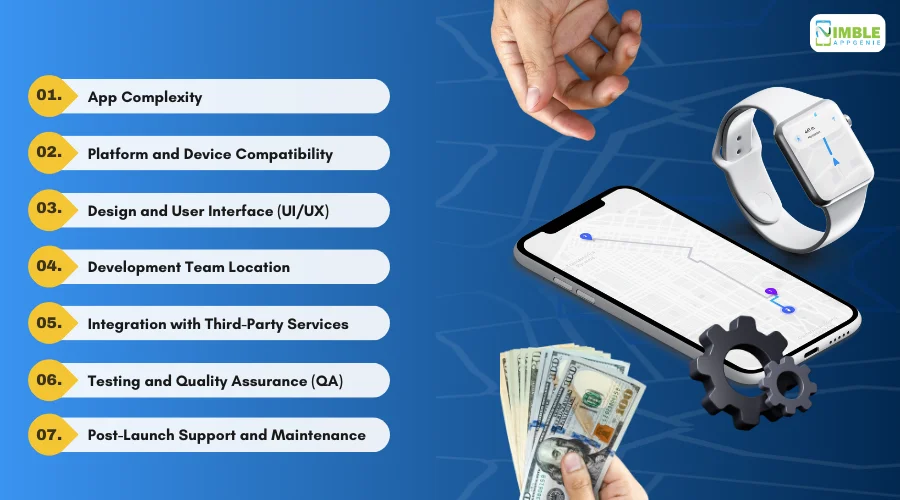
1] App Complexity
The complexity of a wearable app significantly impacts the cost of developing a wearable app.
Simple apps with basic features, such as step counting or heart rate monitoring, tend to be more affordable.
However, apps with advanced functionalities like AI-driven analytics, real-time data synchronization, or AR integration require more time and resources, driving up the development cost.
| Level of Complexity | Features Included | Estimated Cost |
| Simple | Basic tracking and limited features | $30,000 – $60,000 |
| Moderate | Advanced tracking and multiple device support | $60,000 – $100,000 |
| Complex | AI, AR integration, real-time synchronization | $100,000 – $150,000+ |
2] Platform and Device Compatibility
The cost to build a wearable app is also affected by the platform and device compatibility.
Developing for a single platform, such as watchOS (iOS App development) or Android Wear (Android App Development), is more cost-effective.
However, ensuring cross-platform compatibility and supporting a variety of wearable devices (like smartwatches, fitness trackers, and AR glasses) increases the complexity and cost of the project.
| Platform/Device Support | Impact on Cost | Estimated Cost Impact |
| Single Platform | Development of one platform (e.g., watchOS) | Base Cost |
| Multiple Platforms | Cross-platform development (e.g., watchOS, Android Wear) | +$10,000 – $30,000 |
| Multiple Devices | Ensuring compatibility with various devices | +$5,000 – $20,000 |
3] Design and User Interface (UI/UX)
A well-crafted user interface (UI) and user experience (UX) are essential for wearable.
High-quality app design not only enhances the user experience but also adds to the cost to build a wearable app.
Elements such as custom animations, interactive features, and an intuitive layout are key to making a wearable app user-friendly but can increase the overall cost.
Here’s a breakdown of UI/UX Design Cost:
| Design Complexity | Design Features | Estimated Cost |
| Basic Design | Minimalist interface and basic interactions | $5,000 – $10,000 |
| Moderate Design | Custom UI elements and intuitive UX | $10,000 – $20,000 |
| Advanced Design | High-end design, custom animation, interactive UI | $20,000 – $40,000 |
4] Development Team Location
It’s time to hire mobile app developers.
The cost of making a wearable app is heavily influenced by the geographical location of the development team.
This is to say, cost to hire developers becomes a big factor.
Developers in regions such as North America and Western Europe generally charge higher rates due to their expertise and the cost of living in these areas.
In contrast, outsourcing to regions like Eastern Europe or Asia can reduce costs, though it may require more oversight to maintain quality.
| Location | Average Hourly Rate | Impact on Total Cost |
| North America/Western Europe | $50 – $150/hour | Higher Cost |
| Eastern Europe | $30 – $70/hour | Moderate Cost |
| Asia | $20 – $50/hour | Lower Cost |
5] Integration with Third-Party Services
Wearable apps often need to integrate with third-party services, such as APIs for data synchronization, cloud storage, payment gateways, or fitness tracking platforms.
Each integration adds complexity to the project and increases the cost of developing a wearable app.
| Integration Type | Examples | Estimated Cost Impact |
| Basic API Integration | Simple data sync and basic third-party service integration | $5,000 – $10,000 |
| Moderate Integration | Multiple APIs and cloud services | $10,000 – $20,000 |
| Complex Integration | Payment gateways and real-time data processing | $20,000 – $40,000 |
6] Testing and Quality Assurance (QA)
Thorough testing and quality assurance (QA) are vital to ensuring that your wearable app functions correctly across different devices and platforms.
QA involves testing the app’s performance, usability, security, and compatibility.
While essential, extensive testing can add to the cost to make a wearable app, particularly for apps with complex features.
| Testing Scope | Testing Requirements | Estimated Cost Impact |
| Basic Testing | Unit testing and basic functional testing | $5,000 – $10,000 |
| Moderate Testing | Cross-device testing and UI/UX testing | $10,000 – $20,000 |
| Extensive Testing | Comprehensive QA, stress testing, and security testing | $20,000 – $30,000 |
7] Post-Launch Support and Maintenance
Post-launch support and maintenance are essential components of wearable apps.
This includes updates to keep the app compatible with new devices, operating system versions, bug fixes, and ongoing customer support.
Regular maintenance is crucial to ensure that your app remains functional and user-friendly, and it incurs ongoing costs.
Here’s a breakdown of app’s maintenance cost:
| Maintenance Type | Scope of Work | Estimated Cost Impact |
| Basic Maintenance | Bug fixes, minor updates | $2,000 – $5,000/year |
| Moderate Maintenance | Regular updates and minor feature enhancements | $5,000 – $10,000/year |
| Comprehensive Maintenance | Major updates, feature additions, and ongoing support | $10,000 – $20,000/year |
Some Tips to Optimize Wearable App Development Cost
Minimizing the cost to create a wearable app without compromising on quality is a challenge that many businesses face.
However, with careful planning and strategic decisions, it’s possible to optimize the development cost-effectively.
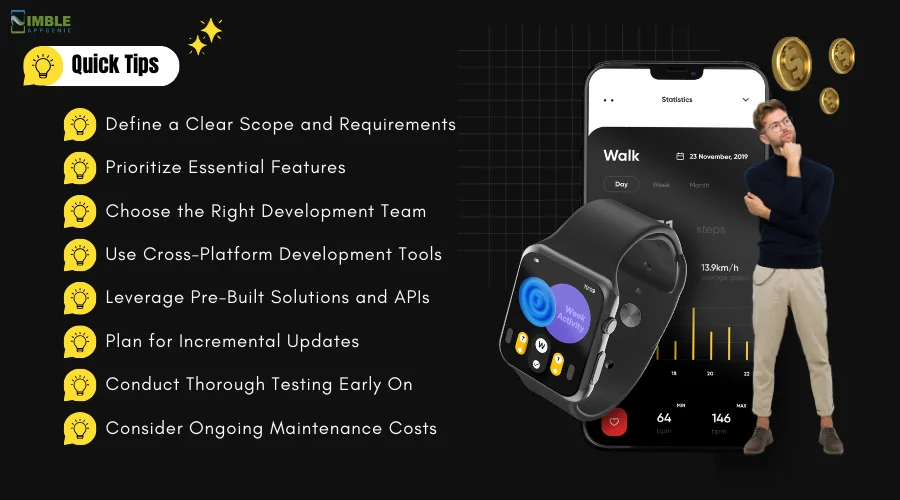
Here are some tips to help you manage and reduce the cost to build a wearable app:
-
Define a Clear Scope and Requirements
One of the most effective ways to control costs is by defining a clear scope and set of requirements from the start.
Understanding exactly what features you need and what the primary objectives of the app are will help avoid unnecessary changes and scope creep, which can drive up costs.
-
Prioritize Essential Features
Focus on developing the core features that are crucial for the app’s functionality and user experience.
By launching with a minimum viable product (MVP), you can test the market and gather user feedback before investing in additional features.
This approach allows you to allocate resources more effectively and avoid overspending on non-essential features.
-
Choose the Right Development Team
The cost of making a wearable app can vary greatly depending on the location and expertise of the development team.
Consider outsourcing to regions where development costs are lower, such as Eastern Europe or Asia, while ensuring that the team has the necessary skills and experience to deliver high-quality results. Freelancers or smaller development agencies might also offer cost-effective solutions.
Also Read: Steps to Outsource Software Development
-
Use Cross-Platform Development Tools
Opting for cross-platform development tools like Flutter or React Native.
This can reduce costs by enabling you to create apps for multiple platforms with a single codebase.
This approach saves time and resources compared to developing separate apps for each platform, such as watchOS and Android Wear.
-
Leverage Pre-Built Solutions and APIs
Where possible, leverage pre-built solutions, libraries, and APIs to accelerate development and reduce costs.
For instance, integrating existing fitness tracking APIs or using pre-designed UI components can save significant time and effort, leading to cost savings.
-
Plan for Incremental Updates
Instead of trying to include every feature in the initial release, plan for incremental updates.
This allows you to spread the development cost over time, focusing on essential features first and gradually adding new functionalities based on user feedback and market trends.
-
Conduct Thorough Testing Early On
Investing in thorough testing early in the development process can prevent costly fixes later.
Identifying and addressing bugs and issues during the early stages of development reduces the likelihood of major problems that could lead to expensive rework or delays.
-
Consider Ongoing Maintenance Costs
To optimize the long-term cost of developing a wearable app, consider the ongoing maintenance costs from the beginning.
Budgeting for regular updates, bug fixes, and compatibility adjustments ensures that your app remains functional and user-friendly without unexpected expenses.
By following these tips, you can effectively manage and reduce the cost of wearable app development, ensuring that you get the most value from your investment without compromising on quality. Let me know if you need any adjustments!
Can You Monetize a Wearable App, Dedicatedly?
Yes, you can monetize a wearable app dedicatedly, and there are several effective strategies to generate revenue.
With the wearable technology market projected to reach $118.16 billion by 2028, there is significant revenue potential for businesses entering this space.
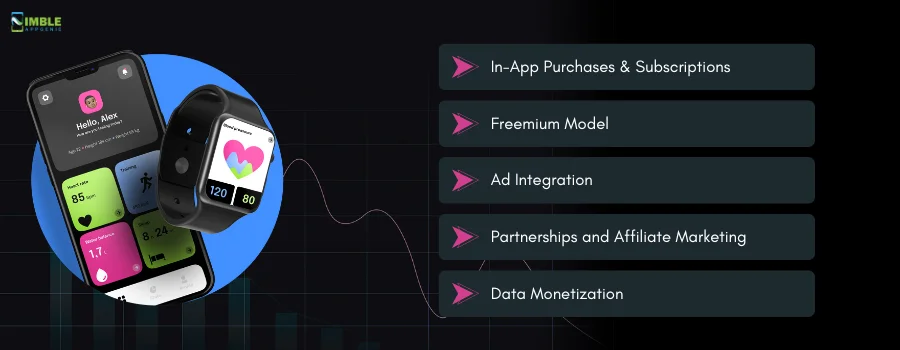
Here are the top monetization strategies:
♦ In-App Purchases and Subscriptions
One of the most effective ways to monetize a wearable app is through in-app purchases and subscription models.
Users can pay for premium features, additional content, or enhanced functionality within the app.
For instance, a fitness tracking app might offer advanced workout plans, detailed health analytics, or personalized coaching for a monthly or annual fee.
The subscription model, in particular, can generate a steady stream of recurring revenue, with potential earnings ranging from $5 to $20 per user per month.
♦ Freemium Model
The freemium model offers a basic version of the app for free while charging for premium features or content.
This strategy attracts a large user base by offering essential functionalities at no cost and encouraging users to upgrade for more advanced features.
The revenue potential depends on the conversion rate from free to paid users.
With an effective strategy, freemium apps can convert 5-10% of users to paying customers, with potential revenue ranging from $1 to $10 per user for premium features.
♦ Ad Integration
Integrating ads into your wearable app is another viable monetization strategy.
Careful placement of ads, such as banners or sponsored content, can generate revenue without disrupting the user experience.
The revenue potential from ads depends on the app’s user base and engagement levels.
Apps with high daily active users can generate substantial revenue through ad impressions, with potential earnings of $0.50 to $3 per thousand impressions (CPM).
♦ Partnerships and Affiliate Marketing
Wearable apps can generate revenue through partnerships and affiliate marketing.
For example, a fitness app might partner with health and wellness brands, offering users discounts on related products or services.
The app earns a commission for each sale made through these affiliate links.
The revenue potential from affiliate marketing can vary widely, but successful partnerships can generate $1 to $10 per sale or a percentage of the sale value, depending on the affiliate agreement.
♦ Data Monetization
Wearable apps often collect valuable user data, which can be monetized, provided it is done ethically and with user consent.
Anonymized data can be sold to research institutions, health organizations, or marketing firms interested in consumer trends and behavior.
While this strategy requires strict adherence to privacy regulations, the revenue potential can be significant, with data sales generating $10,000 to $100,000 or more annually depending on the volume and type of data.
Monetizing a wearable app offers substantial revenue potential when executed with the right strategy. By leveraging in-app purchases, subscriptions, the freemium model, ad integration, partnerships, and data monetization, you can create multiple income streams while delivering value to your users.
Nimble AppGenie, Your Partner in Wearable App Development
At Nimble AppGenie, we are your trusted wearable app development company, dedicated to bringing your innovative ideas to life.
With years of experience in the industry, our team of experts specializes in creating cutting-edge wearable apps that not only meet your business needs but also exceed user expectations.
By partnering with us, you gain access to top-tier expertise, the latest technology, and a commitment to delivering high-quality, cost-effective solutions.
Whether you’re looking to create a simple fitness tracker or a complex health monitoring app, Nimble AppGenie is here to help you succeed in the wearable technology market.
Conclusion
Developing a wearable app is a strategic investment that can offer substantial returns, especially in today’s tech-savvy market. By understanding the factors that influence the cost to build a wearable app and leveraging cost-optimization strategies, you can create a high-quality app that meets user needs without overspending. Whether you’re launching a new product or expanding an existing portfolio, wearable apps represent a significant opportunity for growth and innovation.
FAQs

Niketan Sharma is the CTO of Nimble AppGenie, a prominent website and mobile app development company in the USA that is delivering excellence with a commitment to boosting business growth & maximizing customer satisfaction. He is a highly motivated individual who helps SMEs and startups grow in this dynamic market with the latest technology and innovation.
Table of Contents




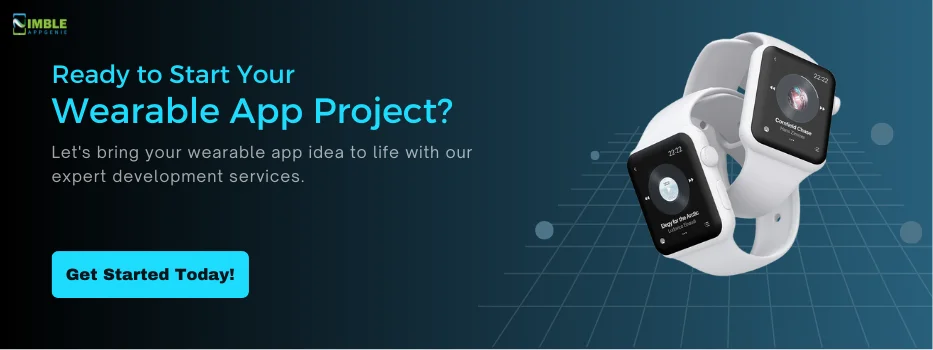
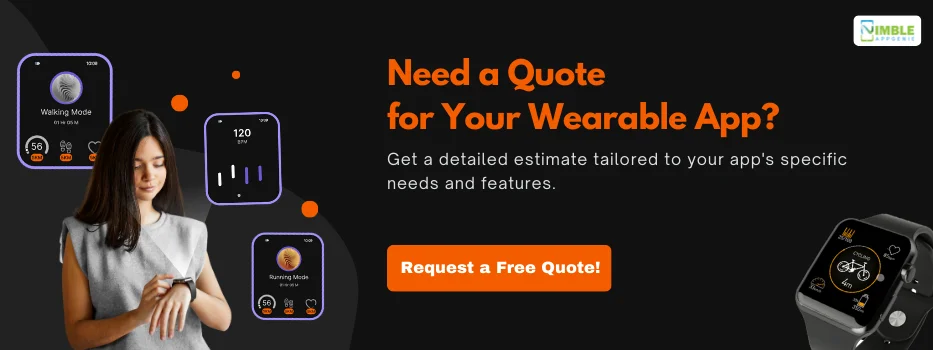
No Comments
Comments are closed.